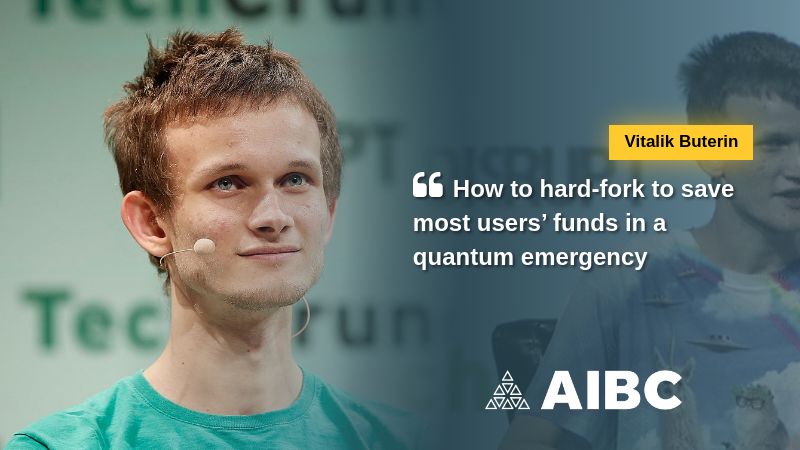Ethereum co-founder Vitalik Buterin’s quantum-proofing strategy for Ethereum

Vitalik Buterin, a co-founder of Ethereum, has outlined a plan to safeguard the network against potential threats from quantum computers. Quantum computers, while still under development, pose a significant risk to blockchain technology as they could crack the encryption currently used to secure transactions.
How to hard-fork to save most users' funds in a quantum emergency
By:
– vbuterinHighlights:
– Quantum computers could potentially break the security of Ethereum, making it possible to steal users' funds by reversing the encryption that protects…— ethresearchbot (@ethresearchbot) March 9, 2024
Ethereum’s Defense Strategy
In a discussion on the Ethereum Research forum, Buterin addressed concerns about the impact of quantum computers on the network’s security. He proposed a multi-pronged approach, with a “hard fork” as the central strategy. In this case, the hard fork would rewind the Ethereum blockchain to a point before a successful quantum attack, protecting user funds.
The Power of Hard Forks and Quantum-Resistant Cryptography
Buterin’s plan hinges on the concept of reverting the network to a secure state after a quantum attack. To achieve this, Ethereum developers are integrating quantum-resistant cryptographic techniques like Winternitz signatures and STARK proofs. These technologies offer enhanced transaction security by safeguarding users’ private keys from potential decryption attempts by quantum computers.
Ethereum has undertaken certain measures to ensure that it continues to remain a reliable and dependable platform for decentralized applications (dApps), cryptocurrencies, and non-fungible tokens (NFTs). These measures are aimed at maintaining Ethereum’s position as a trustworthy platform for digital assets and keeping up with the ever-evolving and rapidly changing landscape of the blockchain industry.
By doing so, Ethereum is striving to provide its users with the best possible experience while fostering innovation and growth in the world of cryptocurrency and blockchain technology.
ETH Holders Pay Attention 🚨
Ethereum’s Dencun upgrade is scheduled for March 13.
It is expected to result in lower fees for users of layer-2 networks.#ETH #Crypto
— Wise Advice (@wiseadvicesumit) March 11, 2024
Proactive Defense Against a Growing Threat
Concerns about the vulnerability of traditional cryptographic defences to quantum computers have been simmering within the blockchain community for some time. Experts estimate that quantum computers powerful enough to break blockchain encryption could emerge around 2029. Buterin’s proactive approach highlights Ethereum’s commitment to user security and the long-term viability of the network.
The hard fork is just one piece of the puzzle. Additionally, developers are exploring alternative quantum-resistant algorithms like Lamport signatures and smart contract wallets to enhance transaction confidentiality further. This multi-faceted approach demonstrates Ethereum’s preparedness to adapt to evolving security threats and safeguard user assets.
Quantum-Proofing for a Thriving DeFi and NFT Ecosystem
The rise of decentralized finance (DeFi) and NFTs has seen billions of dollars locked in various protocols. However, these sectors are also vulnerable to quantum attacks. Ethereum’s efforts to “quantum-proof” its network will have a positive impact on DeFi and NFTs by ensuring a secure environment for users’ digital assets.
Adaptability and Innovation
As the development of quantum computers continues, blockchain networks must remain adaptable and proactive in addressing potential vulnerabilities. Ethereum’s strategy, as outlined by Buterin, underscores the importance of a forward-thinking approach to blockchain security and paves the way for continued innovation in this space.
Recovery Fork: Rolling Back the Damage
In the event of a detected quantum attack, Ethereum would initiate a “recovery fork” to revert the network to a state before the attack occurred. This would rewind the blockchain to a point before stolen funds were moved, mitigating the damage and protecting user assets. While users may need to update their wallet software during this process, the majority of their funds remain safe.
Ethereum Improvement Proposals (EIPs) play a vital role in implementing quantum-resistant solutions on the network. For example, EIP 7560 introduces new transaction types designed for increased security and compatibility with emerging quantum-resistant protocols. Through EIPs, developers and stakeholders can collaborate to ensure a smooth transition to a safer future for Ethereum.









